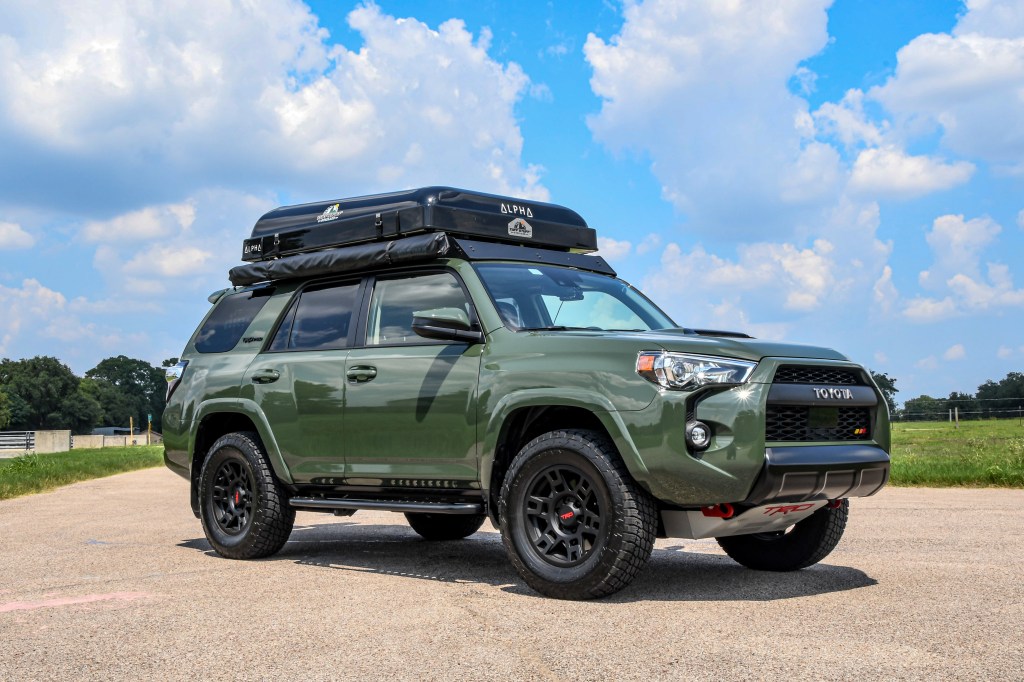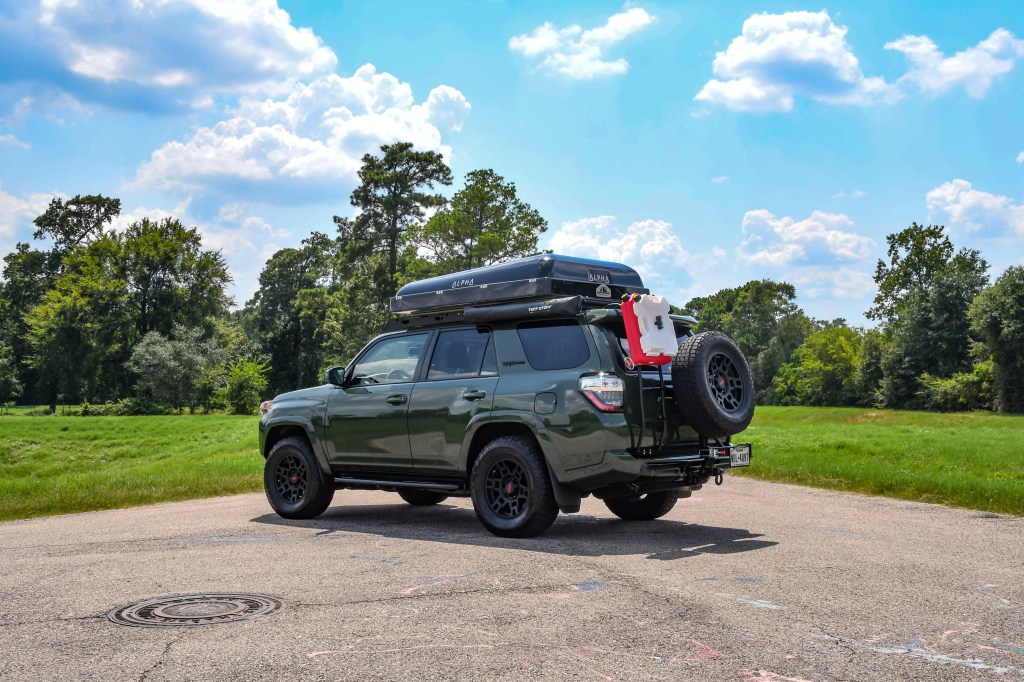
Gunship. That’s the name I gave this 2020 Toyota 4Runner TRD Pro in Army Green. Why Gunship? Because the car I had prior to this one was a 2017 Audi A4 that I had named Spaceship due to it’s ultra-modern all-LED dashboard. Being a former active duty Marine and current National Guard Soldier, it seemed fitting for this very military-looking colored rig to be named Gunship.
Why the 4Runner
There are many reasons I chose the Toyota 4Runner as my personal vehicle, but they include the following:
- Houston floods. I’m in the National Guard, and I need reliable transportation that can handle up to 6″ of water on the roadways safely. The 4Runner can do that.
- Speaking of the National Guard, when I do need to go to drill or annual training, I am required to carry a large amount of equipment that didn’t all fit into my former vehicle easily.
- I fly RC aircraft, and I needed a vehicle with a large enclosed area to transport the planes to and from the airfield.
- My wife and I like going biking and would like to do more hiking and camping. This vehicle will accommodate both of those easily.
- Adventures. The 4Runner is made to have them
What are the mods?
Here is a list of the mods that have been done to the Gunship.
- Shrockworks rock sliders
- Sherpa Equipment Co. Crestone Roof Rack
- Tuff Stuff Overland Alpha Roof Top Tent
- Tuff Stuff Overland Shower Curtain
- Bajarack Ladder
- Shrockworks Ultralight front bumper with Warn Evo12S winch
- Shrockworks rear bumper with swing-out tire carrier, dual-can carrier, and Baja Designs LED backup lights
- Rago Fabrication storage system and shelf and Waterport mount
- Yakima Slim Shady awning
- X-Bull recovery/traction board mounts by Bruce’s Rod Shop
- LED headlights and interior lighting
- ARB Differential Breather
Former Mods No Longer on the Gunship
- Detours Offroad Hardware Trailer Hitch Mounted Tire Carrier
- Apex Overland front recovery points (Excellent, but replaced by the Shrockworks Ultralight front bumper)


Supplies
This is a list of things that I have in my 4Runner at all times. While some may be overkill for daily driving or “Mall Crawling” as the wheeling community likes to call it when you’re not actually driving off-road, I prefer to be prepared for anything that comes my way. That’s part of the reason I drive a 4Runner: to not be caught off-guard by the weather, by terrain, or any other unforeseen situation (if I can help it). NOTE: The items listed below are the ACTUAL items I have. I have used every one of these personally.
- Safe Jack bottle jack. I prefer to use this over a Hi-Lift or a farm jack.
- Rotopax 3.5 Gallon Fuelpax. 3.5 gallons of fuel is an additional 40 miles of fuel. I’ve run short by 3 miles before (in another vehicle long ago). I don’t want that experience again.
- Rotopax Water Pack. This is a 2 gallon container that fits onto the back of the vehicle as another backup to the two larger water jugs we use for water.
- Waterport. This holds about 3.75 gallons of water in a black container which allows it to heat up outdoors during the day which makes for a nice shower before bedding down.
- Dometic CFX3-55 Refrigerator/Cooler. We initially purchased the CFX3-100, but that turned out to be too big for our use case. We down-sized to the CFX3-55, and it’s perfect for us. It uses very little electricity, and is very efficient, allowing it to remain cool for over 24 hours even when not plugged in. This cooler even has a small ice tray area to make ice cubes (my wife’s favorite feature)! I like the Bluetooth connectivity and miserly energy draw.
- Jackery Portable Power Station Explorer 1000 solar genertator. This is the hands-down favorite of just about every Overlander I know. It’s got incredibly good reviews, the company is solid and very attentive, and the product uses quality parts. I can power my Dometic with this for five days before a charge. That’s pretty incredible!
- Military folding shovel (aka E-Tool, or Entrenching Tool). The e-tool I received was authentic. I compared it to my actual issued e-tool, and it’s identical. This is a great item to have just in case. If you ever go off-road, it’s likely you’ll need a shovel at some point. This one doesn’t take up much space and is actually tough and efficient.
- Fire Extinguisher. If you’re going to be out in the middle of nowhere and you have a minor fire, it can quickly escalate into losing your entire vehicle (and everything in it). Give yourself a fighting chance of saving your vehicle by carrying a fire extinguisher.
- Recovery straps/D-Ring (Bow Shackles). Recovery. You can’t do it without straps.
- Tree Saver Winch Strap. Even if you don’t have a winch, if you’re going to use a snatch strap to pull yourself or anyone else out, it’s always a good idea to distribute the force between two recovery points.
- Chock Blocks. If you’re going to be under your vehicle for ANY reason, you should always chock it. I’ve seen people seriously injured by moving vehicles.
- Hand axe. If you’re going on trails, especially lesser-driven ones, having a small hand axe may save you some pinstripes on your precious rig, or more importantly, allow you to clear an obstructed path.
- Survivorware First Aid Kit. Yes, it’s pricey. But one thing you never want to cheap-out on is first aid. This is gear that may be called on to save your life or the life of a loved one. This kit is very full-featured, well organized, and made of quality material with high-quality contents. I can’t recommend it enough. It also comes with a tourniquet (when you register your product with them).
- Tire Pressure Gauge. If you’re going off-road, whether it’s gravel, dirt, or sand, you should always lower the pressure of your tires to reduce the risk of getting stuck and to reduce the wear and tear on your tires.
- Air Compressor. If you’re lowering the pressure of your tires to go off-road, you’ll need to air them back up to go on the road. This air compressor does the trick fairly quickly. This is what I would call the value, or less expensive option. What I now use, however, is the next item.
- Powertank. I’ve recently converted from the Air Compressor listed above to a Powertank. The reasons are because the Powertank fills tires much more quickly (average 30-45 seconds per tire from 15 psi to 40 psi), has no moving parts, and is portable/easy to deploy. I can refill my tires around 40 times per refill of CO2.
- D-Rings/Bow Shackles. You use these to attach recovery straps to your vehicle. These are highly rated and high quality.
- Winch Cable/Recovery Strap Blanket. This is safety equipment you should never recover without.
- Trailer Hitch Locking Pin. I keep a bow shackle recovery point on my hitch, and I’d prefer that nobody steal it, so this is a good option to lock it down.
- X-Bull Recovery Tracks/Recovery Boards. My son got these for me for Christmas, and while there are other options available, these are a good budget-friendly alternative. Will they be as tough as the high-end tracks? In all the testing I’ve seen, probably not, but they will get you out at least once or twice which will save you hundreds (or thousands) in recovery fees if you need to call in someone for help. Good insurance, if you ask me.
- Sceptor 5 Gallon Water Jugs. These are exactly the same water jugs used by the US Military, and it is from my experience with these containers that I purchased two of these. I’ve watched Marines and Soldiers throw these from vehicles and even when full of water, they did not break, crack, or distort. They are nearly indestructible and do not impart any plastic taste on the water.
- Water Bottle Pump. This is one of the neatest and least expensive creature comforts we’ve purchased; a water pump that sits on top of the water jugs and allows water to be pumped out without needing to tip the water jug. It adds a faucet to your water jug!
- TACKLIFE T8 800A Peak 18000mAh Car Jump Starter. When using your rig’s battery far away from help, having a car jump starter is peace of mind and ensures you can get your rig started in the event that you accidentally drained your battery. It’s well worth the cost.
- Dormco Iron Brick Trunk. We purchased two of these to organize the back of the Gunship. One contains all our kitchen gear while the other contains our general campsite gear. These boxes are tough, and they have wheels to help move them. They are very similar to the boxes we use in the military.
- RUX boxes. These are fantastic new products that make storage simple and light. We changed out one of the Iron Bricks for two RUX and gained a lot of room without losing any space to store things.
A note about budget
Some people might notice that some of the items on my list of mods and/or supplies are pricey. That’s not by accident, and it’s not because I only buy the most expensive items. In most cases, the items are actually not the most expensive, but they are by no means the cheapest. I subscribe to the “Buy once, cry once” mindset that my grandparents instilled into me from childhood.
My grandparents lost everything twice; first due to WWII, and the second time due to the Hungarian Revolution. When they purchased items, they bought them for life. They reasoned that it may cost more up-front, but if you don’t have to replace an item due to its quality, in the end, you’ve saved money. In the past, I didn’t listen to this advice and bought less-expensive (or cheaper) items and ended up regretting it. Each time I re-purchased an item, I would hear my grandparents admonishing me from above.
There are always areas in which you can save money, but in other areas, it’s foolish to do so. First aid, recovery, safety, and equipment you rely on for comfort or subsistence are all areas in which you should purchase the best you can for your budget.
There are lots of ways to do Overlanding on a budget. I did it when I was in my 20’s with an old VW Vanagon and camping equipment I checked out for free from the MWR (Morale, Welfare, and Recreation) office on the base I was stationed at when I was on active duty in the Marines. Had I not been able to check out the gear for free, I would have likely purchased second-hand gear from one of the many resale shops that were local. Now that I’m older, I can afford to spend a little more on better quality gear.
Drop me a line
ej@paleomarine.com
Let’s hang out